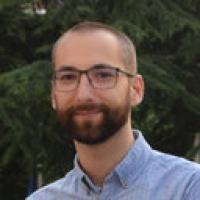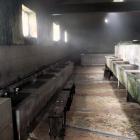Situated within the Rhodope Mountains in Southern Bulgaria, the village of Draginovo possesses thermal springs reaching 96.5°C. Predominantly inhabited by Pomaks (Bulgarian-speaking Muslims), Draginovo is part of a region with a long history of interactions between people and hot mineral waters. Nevertheless, an episode from its history disrupted the local hydrosocial relations, highlighting entrenched power hierarchies that have shaped a distinctive mnemonic waterscape.
People’s attachment to their territory finds expression in the reverence for their thermal waters, woven into both ritual and everyday life. Communal bathhouses serve as integral places for regular activities of bathing or doing laundry, offering a sentiment that “you can’t bathe so well at home” and that “this water washes better than the washing machine.” These are often social activities, with some relishing the experience by snacking in the bathhouse, enjoying the pleasure of dipping bread into the hot water. Additionally, the practice of bathing “for health” with herbs and flowers during the Gergjovden (St. George’s Day) spring festivities, along with the bridal bathing before weddings, persist as living traditions.

Green herbs and flowers in one of the public mineral baths in Draginovo during the Gergjovden (St. George’s Day) spring festivities (observed by various ethnoreligious communities in the beginning of May).
Green herbs and flowers in one of the public mineral baths in Draginovo during the Gergjovden (St. George’s Day) spring festivities (observed by various ethnoreligious communities in the beginning of May).
2023 Ivo Strahilov
 This work is licensed under a Creative Commons Attribution 4.0 International License.
This work is licensed under a Creative Commons Attribution 4.0 International License.
The history of bathing facilities and their incorporation in the local landscape reveals a more complex picture. In 1971, Socialist authorities destroyed the local cemetery, erecting a public bath in its place. The Muslim cemetery met an abrupt end “without warning,” etched vividly in the memories of an eyewitness—a student at the time—who recalls the distressing scene as “two bulldozers arrived and began to level the ground. We watched how bones, people’s skulls came boiling out of the ground.”1 This anti-Muslim act, presented as modernisation, triggered local disapproval and rejection of the bathhouse. The community considered bathing there an act of sacrilege: “People didn’t want—your parents, your relatives are buried there, and it was a crime to go there to bathe!”
This incident unfolded within a broader context of assimilationist policies targeting Pomaks, whose Muslim names were forcibly changed. The village was also renamed from Korovo to Draginovo, honouring Orthodox priest Metodi Draginov, whose chronicle (suspected to be a literary fabrication) was instrumentalized to reinforce the theory of Bulgarians’ forceful Islamisation by the Ottomans in the seventeenth century. Furthermore, the Socialist regime’s actions re-actualized earlier traumatic events like the Pomaks’ forced Christianisation in 1913, prompting numerous inhabitants of the then-Korova to seek refuge in Turkey and settle in the village of Akören. Local historian Milen Nalbantov (2016: 163–64) notes the mosque’s conversion to “Temple St. Basil” with its minaret destroyed and replaced by a belfry.
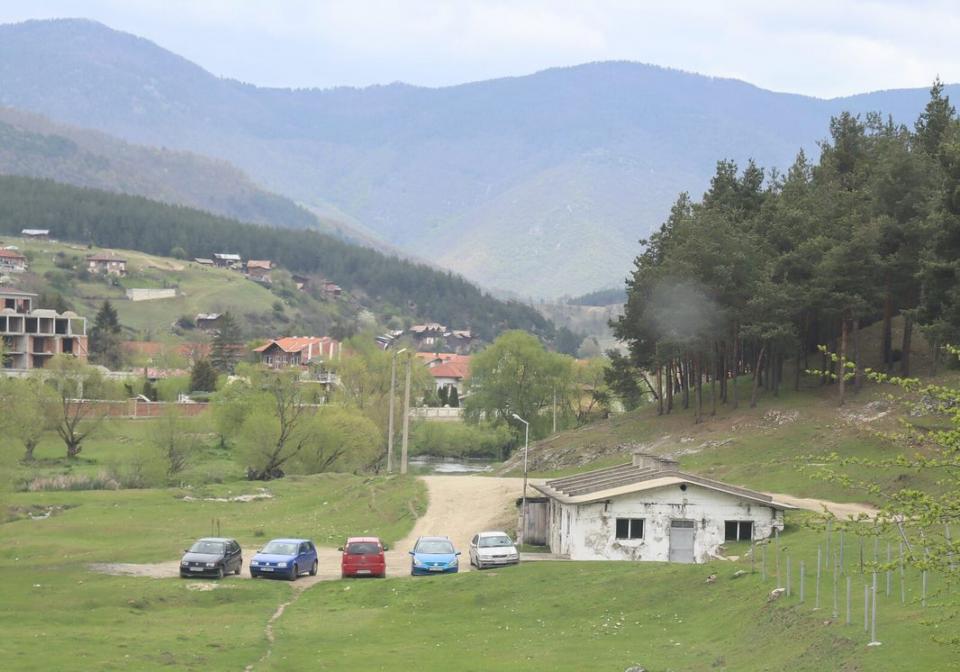
2023 Ivo Strahilov
 This work is licensed under a Creative Commons Attribution 4.0 International License.
This work is licensed under a Creative Commons Attribution 4.0 International License.
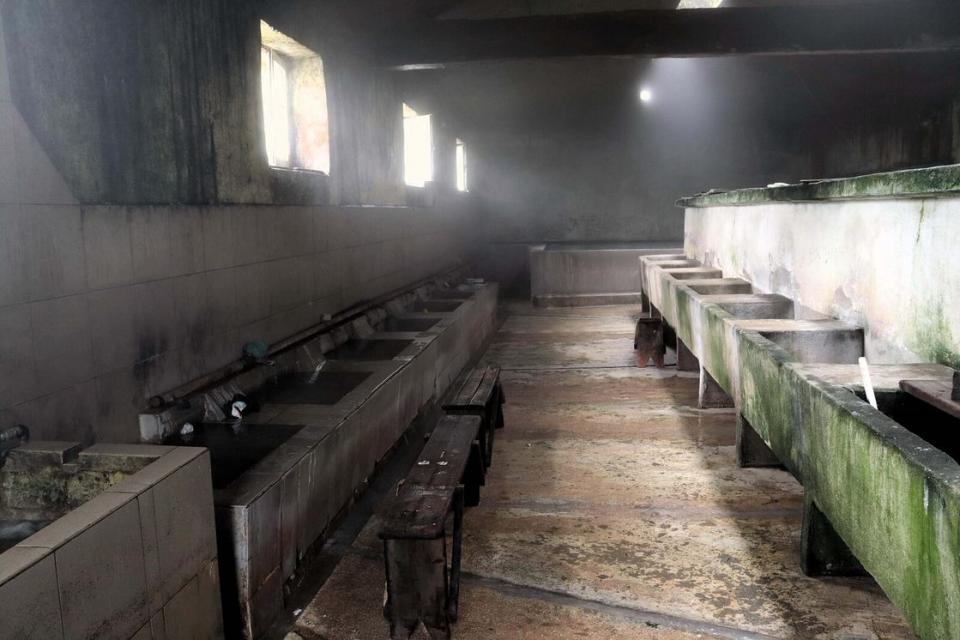
2023 Ivo Strahilov
 This work is licensed under a Creative Commons Attribution 4.0 International License.
This work is licensed under a Creative Commons Attribution 4.0 International License.
One of the three public mineral baths in Draginovo, used also as a laundry.
The Draginovo case echoes the mass obliteration of Muslim cemeteries throughout Bulgaria, revealing specific environmental entanglements of the assimilationist practices. The bathhouse built “by force” was linked by a pipeline to a thermal spring in the nearby municipal centre of Velingrad. While water was channelled to Draginovo, villagers faced constraints accessing baths in Velingrad, which developed as a nationally important balneotherapy resort, inheriting Ottoman bathhouses’ infrastructures and traditions. These restrictions amplified a sense of discrimination, leaving an imprint on collective memory: “People were in categories—first and second category. Some were humans, others were animals.” Women further recount being denied public transport to the town for wearing headscarves, as Islamic traditions and dress had to be eradicated as incompatible with the appropriate Bulgarian identity.
Avenues for resistance were limited: “People resented [the bath] and didn’t want to use it. But you can’t go against the government!” The community’s dissent was manifested in avoidance of the bathhouse, trying to make use of available thermal waters. They appropriated natural springs in the river, where cold and hot water could mix. The so-called “shells” were crafted there as improvised bathing facilities. Known as the “Korovo’s bath,” they are still used as a place for relaxation and are considered a village emblem, illustrating the community’s attachment to thermal water. The idiom “moving like the Korovo’s bath,” describing impermanent things, follows the example of the “shells” that constantly “move” in the river because people “catch” the moving hot springs. During the 1970s, however, these open-air alternatives posed discomfort.
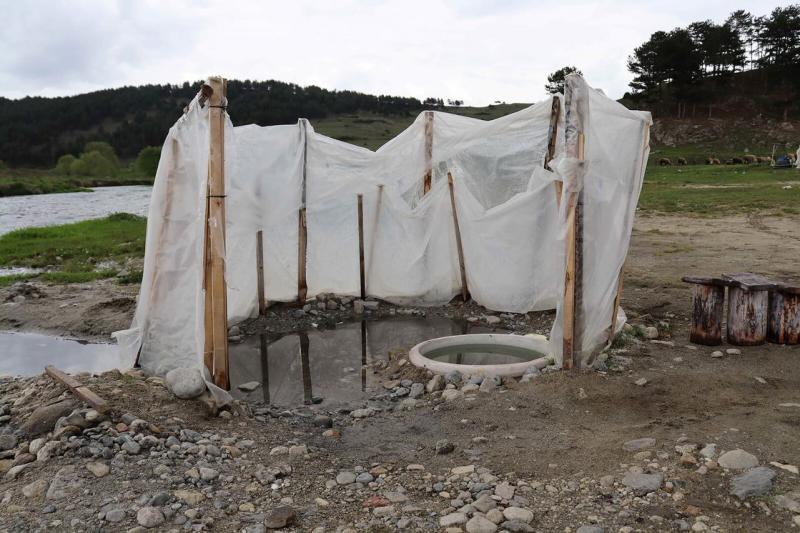
2023 Ivo Strahilov
 This work is licensed under a Creative Commons Attribution 4.0 International License.
This work is licensed under a Creative Commons Attribution 4.0 International License.
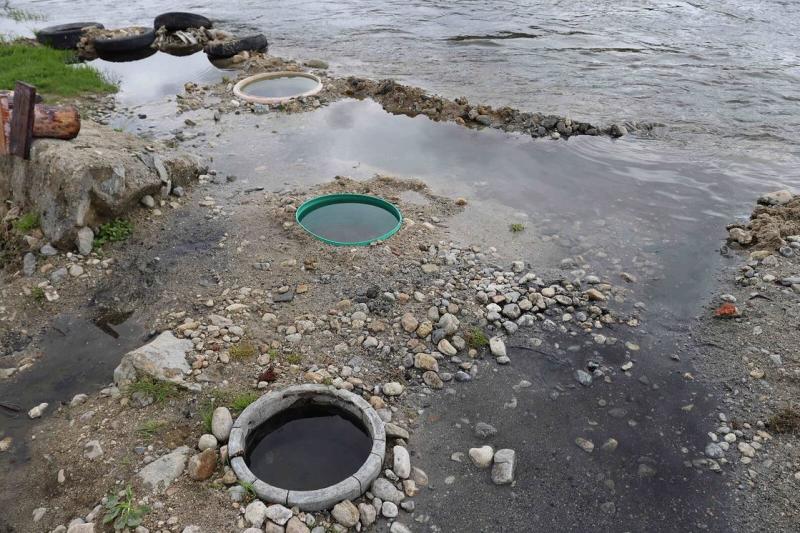
2023 Ivo Strahilov
 This work is licensed under a Creative Commons Attribution 4.0 International License.
This work is licensed under a Creative Commons Attribution 4.0 International License.
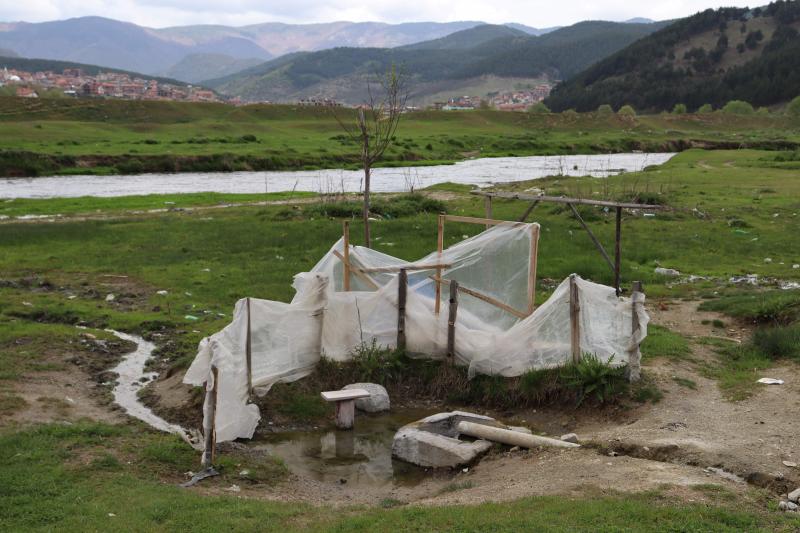
2023 Ivo Strahilov
 This work is licensed under a Creative Commons Attribution 4.0 International License.
This work is licensed under a Creative Commons Attribution 4.0 International License.
The “shells” (Bulgarian: čerupki) capturing natural springs of hot mineral water in the river.
This unfavourable situation changed in 1980 when a new mayor built another public bath, while the previous one was transformed into a kindergarten. In the 1990s, after the Socialist regime’s collapse, two more bathhouses emerged in different neighbourhoods. Presently, four local boreholes provide heating for community facilities, including a school, kindergarten, community centre, pensioners’ club, mosque, and village hall. The three bathhouses and four public fountains supplied with mineral water operate 24 hours a day. Access is free, which also attracts people from the region unable to afford commercial facilities. Local families contribute BGN 10 (approx. EUR 5) every six months, with additional voluntary donations. This community model reflects the local understanding of the socionature of water and contrasts with the situation in Velingrad where, as Segond and Monova (2023) underline, public access to thermal water has diminished due to spa hotels’ expansion.
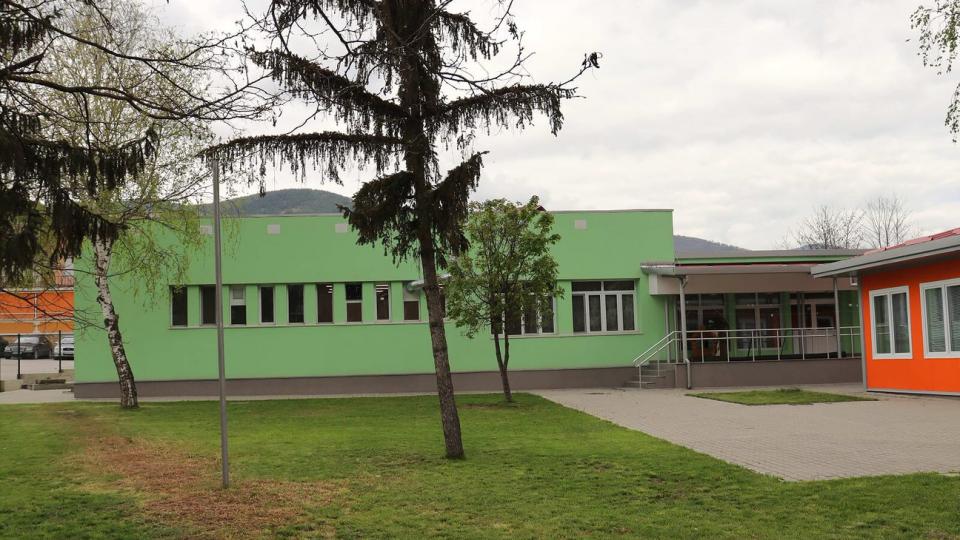
The building of the former public bath has been transformed into a kindergarten (renovated in 2019).
The building of the former public bath has been transformed into a kindergarten (renovated in 2019).
2023 Ivo Strahilov
 This work is licensed under a Creative Commons Attribution 4.0 International License.
This work is licensed under a Creative Commons Attribution 4.0 International License.
The case of Draginovo highlights the silenced environmental histories of ethnic and religious communities behind Velingrad’s prestigious title of “Spa Capital of the Balkans.” In this town, segregated Romani neighbourhoods suffer potable water scarcity, bathhouses are often racially labelled as “Gypsified,” while Muslim culture remains rather invisible. Conversely, a commemorative fountain now graces the centre of Draginovo, symbolising the connection between locals and their relatives in Akören. Adorned with a Quranic verse celebrating the sanctity of water—“We made from water every living thing”—this fountain underscores water’s significance, intertwining traumatic memories and reclaimed place that unite the community across national borders.
1 All quotations in this article come from interviews conducted and transcribed in 2023. The fieldwork was conducted by the author together with Raphaëlle Segond, Meglena Zlatkova, Miladina Monova, Olivier Givre, and Marina Chauliac within the project “European Water Towns: Comparative Aspects of the Regional Development of the Cases of Vichy, France, and Velingrad, Bulgaria,” funded by the Bulgarian National Science Fund (agreement no. КП-06-РИЛА/9, 16 December 2021) and supported by the French Embassy and the French Institute in Bulgaria.
How to cite
Strahilov, Ivo. “Boiling Memories: Thermal Waters as Nexus of Trauma and Community Agency in Draginovo’s Mnemonic Waterscape.” Environment & Society Portal, Arcadia (Spring 2024), no. 4. Rachel Carson Center for Environment and Society. https://www.environmentandsociety.org/node/9829.
ISSN 2199-3408
Environment & Society Portal, Arcadia
 This work is licensed under a Creative Commons Attribution 4.0 International License.
This work is licensed under a Creative Commons Attribution 4.0 International License.
2024 Ivo Strahilov
This refers only to the text and does not include any image rights.
Please click on an image to view its individual rights status.
- Benovska-Sabkova, Milena. “In Search of One’s Own Self: Identity of the Bulgarian Muslims (Pomaks). A Case Study from the Western Rhodopes.” In Interculturalism and Discrimination in Romania: Policies, Practices, Identities and Representations, edited by Francois Ruegg, Rudolf Poledna, and Calin Rus, 187–201. Berlin: LIT Verlag, 2006.
- Gruev, Michail, and Alexei Kalionski. “Văzroditelnijat process.” Mjusjulmanskite obštnosti i komunističeskijat režim: politiki, reakcii i posledici [The “revival process.” Muslim communities and the Communist regime: policies, reactions and consequences]. Sofia: Institute for Studies of the Recent Past, 2008.
- Karpouzoglou, Timothy, and Sumit Vij. “Waterscape: A Perspective for Understanding the Contested Geography of Water.” WIREs Water 4, e1210 (2017). doi:10.1002/wat2.1210.
- Nalbantov, Milen. Iskri ot žarava [Sparks from embers]. Velingrad: Historical Museum–Velingrad, 2016.
- Olson, Laura J. “Enacting Pomak Belonging: Wedding Performance and Social Media in Post-Socialist Bulgaria.” Anthropology: Journal for Sociocultural Anthropology 6 (2019): 104–30.
- Peychev, Stefan. “Water and the City: Ottoman Sofia in the Early Modern Period.” In Living with Nature and Things: Contributions to a New Social History of the Middle Islamic Periods, edited by Bethany J. Walker and Abdelkader Al Ghouz, 139–58. Göttingen: Vandenhoeck & Ruprecht Verlage, Bonn University Press, 2020.
- Segond, Raphaëlle, and Miladina Monova. “Meždu odomašnjavane i ostokovjavane. Mineralna voda, infrastrukturi i napreženija v hidrosocialnija cikăl na Velingrad [Between domestication and commodification. Mineral water, infrastructures, and tensions in the hydrosocial cycle of Velingrad].” Anthropology: Journal for Sociocultural Anthropology 10, no. 2 (2023): 9–45.


